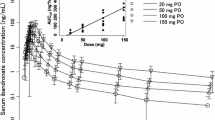Abstract
The aim of the present paper was to delineate in detail the dose-dependent effects of intermittent intravenous (IV) ibandronate treatment on the dynamics of markers of bone resorption and formation. The study included 73 healthy postmenopausal women between 50 and 70 years of age. Two groups received an IV injection of either 1 mg or 2 mg ibandronate on day 0 and 84 and one group, which received no treatment, served as control. Study duration was 168 days. Bone turnover was estimated by measuring the serum concentration of the C-terminal collagen I telopeptide (s-CTx, bone resorption) and osteocalcin (s-OC, bone formation) at 19 consecutive time-points. Serum CTx decreased rapidly reaching a nadir 7 days after drug administration. Maximal changes from baseline in the 1 and 2 mg ibandronate groups were −81% and −90%, respectively (P<0.001). However, already 2 weeks after drug administration, s-CTx started to rise again in both treatment groups, reaching −16% and −20% by day 84, i.e. immediately before the second drug administration. In contrast, s-OC showed a slower but progressive decrease over time reaching a nadir at −35% inhibition after 5 months. On a group level, the suppression of bone resorption was greater or equal to the suppression of bone formation at all time points. However, the least significant change (LSC) analysis performed at the individual level highlighted individuals who at certain time points showed apparently greater suppression of formation than resorption, which could also contribute to the inefficacy of this dosing regime. Although the physiological relevance of this latter finding would require further analysis, the results draw attention to the need to optimize the intermittent IV dosing of ibandronate in order to approximate more closely the sustained and balanced anti-resorptive effect provided by daily oral treatment.


Similar content being viewed by others
References
Ettinger B, Pressman A, Schein J (1998) Clinic visits and hospital admissions for care of acid-related upper gastrointestinal disorders in women using alendronate for osteoporosis. Am J Manag Care 4:1377–1382
de Groen PC, Lubbe DF, Hirsch LJ, Daifotis A, Stephenson W, Freedholm D, Pryor-Tillotson S, Seleznick MJ, Pinkas H, Wang KK (1996) Esophagitis associated with the use of alendronate. New Engl J Med 35:1016–1021
Delmas PD, Eastell R, Garnero P, Seibel MJ, Stepan J for the Committee of Scientific Advisors of the International Osteoporosis Foundation (2000) The use of biochemical markers of bone turnover in osteoporosis. Osteoporosis Int 6:S2–17
Christgau S, Bitsch-Jensen O, Bjarnason NH, Henriksen EG, Qvist P, Alexandersen P, Henriksen DB (2000) Serum CrossLaps for monitoring the response in individuals undergoing antiresorptive therapy. Bone 26:505–511
Ravn P, Clemmesen B, Riis BJ, Christiansen C (1996) The effect on bone mass and bone markers of different doses of ibandronate: a new bisphosphonate for prevention and treatment of postmenopausal osteoporosis: a 1-year, randomized, double-blind, placebo-controlled dose-finding study. Bone 19:527–533
Thiebaud D, Burckhardt P, Kriegbaum H, Huss H, Mulder H, Juttmann JR, Schoter KH (1997) Three monthly intravenous injections of ibandronate in the treatment of postmenopausal osteoporosis. Am J Med 103:298–307
Recker RR, Stakkestad JA, Felsenberg D et al. (2000) A new treatment paradigm: quarterly injections of ibandronate reduce the risk of fractures in women with postmenopausal osteoporosis (pmo): results of a 3-year trial. Osteoporosis Int 11, suppl 2:abstract 565
Okabe R, Nakatsuka K, Inaba M, Miki T, Naka H, Masaki H, Moriguchi A, Nishizawa Y (2001) Clinical evaluation of the Elecsys beta-CrossLaps serum assay, a new assay for degradation products of type I collagen C-telopeptides. Clin Chem 47:1410–1414
Rosenquist C, Qvist P, Bjarnason N, Christiansen C (1995) Measurement of a more stable region of osteocalcin in serum by ELISA with two monoclonal antibodies. Clin Chem 41:1439–1445
Ravn P, Clemmesen B, Christiansen C for the Alendronate Study Group (1999) Biochemical markers can predict the response in bone mass during alendronate treatment in early postmenopausal women. Bone 24:237–244
Adami S, Christiansen C, Burdeska A, Coutant K, Mahoney P (2002) Three-monthly 2 mg intravenous ibandronate injections restore bone turnover to premenopausal levels. J Bone Metab Res 17:S472, M347
Author information
Authors and Affiliations
Corresponding author
Rights and permissions
About this article
Cite this article
Christiansen, C., Tankó, L.B., Warming, L. et al. Dose dependent effects on bone resorption and formation of intermittently administered intravenous ibandronate. Osteoporos Int 14, 609–613 (2003). https://doi.org/10.1007/s00198-003-1409-0
Received:
Accepted:
Published:
Issue Date:
DOI: https://doi.org/10.1007/s00198-003-1409-0




